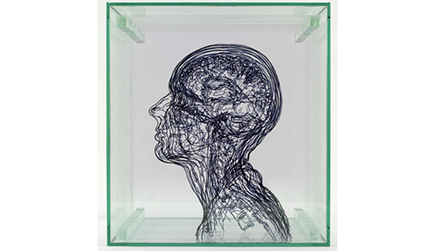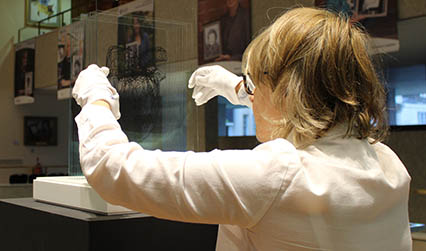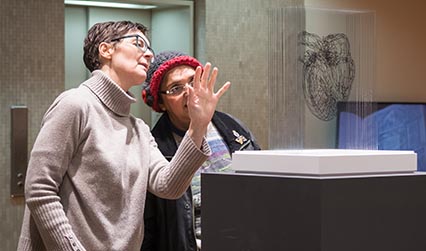In January 2018, RCP museum commissioned a contemporary artist to respond to its historical collections for the first time. Angela Palmer’s new piece ‘Heart’ is inspired by legendary anatomist, William Harvey and is on display in the exhibition ‘Ceaseless motion: William Harvey’s experiments in circulation’ until 26 July 2018.
Working with the Visible Heart Laboratory at the University of Minnesota, Palmer used a series of MRI scans of a cannulated heart (filled with formaldehyde to retain its shape) to recreate a human heart as a three-dimensional drawing on glass that appears to float in space.
In this post, Natalie Craven interviews Angela Palmer about her work and fascination with art and science.
NC: You often in your work collaborate and seek the expertise of medical professionals. How has this affected your practice and has it in any way changed your way of working?
AP: I think every piece of work I have produced has been borne from collaboration with scientists. I have worked with every conceivable discipline over the years, from hospital radiologists, veterinary surgeons, astrophysicists, Egyptologists, bio-fluidic engineers, even dust mite specialists for a project on asthma. Each working partnership involves lengthy discussions and exchanges, from which we amass the available material and begin to visualise the possibilities of final piece.

NC: What do you find most interesting or most enjoy about combining the work of different disciplines?
AP: The endless possibilities each discipline offers; science is about pushing boundaries and breakthroughs, it is a breeding ground for artists who are ever thirsty to acquire material for new explorations. I often see myself as a parasite, living off the generosity of scientists - but hopefully a creative parasite who offers new ways of looking.
NC: Did you have any preconceived ideas of working with medical professionals; was there anything that surprised you?
AP: For me, preconceptions stultify creativity - the best concepts are the ones that evolve and change, often dramatically, rather than the artist following a straight process. Experimentation and a search into the unknown is vital for an artist, together with a willingness to embrace the unexpected, however bizarre and extreme.
Most memorably, my perceptions changed when I was working on a Wellcome exhibition in 2007 capturing the cleanest place in the world and the filthiest place on earth. My concept was to wear a white outfit in both places for a week and exhibit them side by side. I dreaded my visit to the filthiest - Linfen in Shanxi Province in China with its reports of thick black polluted air, and inhabitants coughing blood, suffering premature deaths and animals lying dead on the streets. I thought I would thrive in the cleanest place - Cape Grim, in the North West tip of Tasmania. I was stunned to find that despite adversity (or perhaps because of it) the population in Linfen seemed full of spirit; they were buoyant and alive: sharing the cooking on oil drums on the streets, playing games on makeshift tables outdoors, enjoying a strong sense of community. By contrast, The Tasmanian reserve was daunting. Barely a soul was on the street. People were tucked away in their houses behind net curtains. Picket fences surrounded properties. I began to feel lonely and to yearn for the sense of community that had been so electrifying in the streets of Linfen. As a result, the exhibition at the Wellcome Collection centred on a film, juxtaposing a glimpse of both lives; the white outfits, along with the air and water samples I captured for scientific study, became almost irrelevant.
All religions, arts and sciences are branches of the same tree. All these aspirations are directed toward ennobling man's life, lifting it from the sphere of mere physical existence, and leading the individual towards freedom.
Albert Einstein

NC: What do you think medical practitioners can learn from artists and vice versa?
AP: I think art is a way of 'seeing' science; inevitably, collaboration is a learning process on both sides, and we learn from each other. Albert Einstein said: ‘All religions, arts and sciences are branches of the same tree. All these aspirations are directed toward ennobling man's life, lifting it from the sphere of mere physical existence, and leading the individual towards freedom.’ Scientists give artists the technical capability and vision to experiment and explore and push boundaries. Just as importantly, scientists bring their own perspectives and their own creativity to the artistic endeavour, so every project is a team effort.
NC: You mention in your description of your new work that you were inspired by chemist Dorothy Hodgkin who won the Nobel Prize for Chemistry in 1964. When did you come across Dorothy Hodgkin and what was it about her work that inspired you?
AP: One of the privileges of being a student at the Ruskin School of Drawing and Fine Art in Oxford is the anatomy course, where students are given access to study and draw corpses in the medical schools. For one project, we were asked to create a three-dimensional work based on our anatomy lessons. Inspiration came when I was in the History of Science Museum in Oxford when my eye fell upon an intriguing exhibit by the Nobel Laureate Dorothy Hodgkin, which she had constructed in the 1940s. With a thick black pen, Hodgkin had drawn the electron density contour images of the penicillin molecule on horizontal sheets of acrylic. These sheets were separated at each of the four corners with metal nuts, and the molecules took on a three dimensional form. It was a very beautiful object, and it struck me I could adapt Hodgkin's method by drawing details of the human form on multiple sheets of glass.

NC: Art and science have always interconnected in the way that both disciplines attempt to question what we know. What is it about this intersection that most interests you?
AP: I think we recognise in each other a common need, almost an urgency, to explore and experiment, a shared curiosity to find new ways of looking, of seeing, and of representing ourselves. The post-revolutionary artist Alexander Rodchenko proclaimed: ‘It is our duty to experiment.’ I hope through some of my work I prompt people to see the world through a new lens that it impels them to look afresh on something they may not have previously noticed nor considered.
NC: Whether it be William Harvey dissecting the human body or engineers disassembling machines; taking things apart to understand how they work is a natural human instinct. What was it that led you to deconstruct objects?
AP: My fascination began as a school child in geography lessons, studying contour lines of Ordnance Survey maps (lines redolent of Dorothy Hodgkin's laboratory model). I gradually became drawn to layers, whether it be the slices of a red cabbage, the cross sections of a Formula 1 engine or the internal architecture of the human form. When the viewer passes to the side of the object, the form disappears: there is nothing there but sheets of glass held on a base.
NC: As you often work with healthcare practitioners and specialists, it seems natural that your work would fit a healthcare environment, do you have any plans of this?
AP: Soon! I have created a dramatically up-scaled version of the heart you have at the RCP, and this will be acquired and exhibited at the new Royal Papworth in Cambridge later this year, again using scans provided by the Visible Heart Laboratory at the University of Minnesota.
Angela Palmer has had previous solo exhibitions at the Hunterian museum, The Royal College of Surgeons; Ashmolean, Oxford and Wellcome Collection, London. Her work is held in permanent collections including the Smithsonian air and space museum, Washington; Ashmolean museum and The National Portrait gallery, Scotland.
Angela Palmer’s commissioned work ‘Heart’ can be seen in the RCP museum exhibition ‘Ceaseless motion: William Harvey’s experiments in circulation’ until 26 July.
Natalie Craven, public programmes officer
